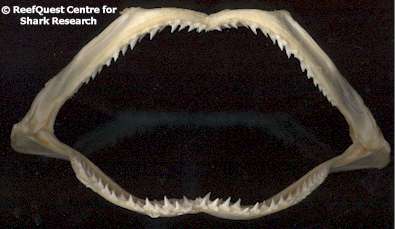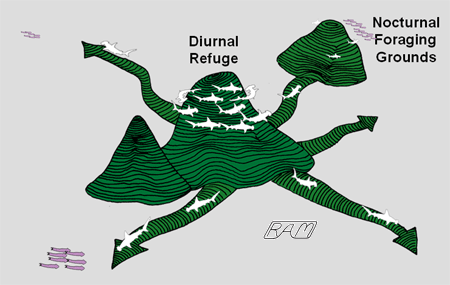Scalloped Hammerhead
(Sphyrna lewini) FAQ

Why do hammerhead sharks have flattened heads?
No one is sure why hammerheads have such a strange, flattened head. The hammer itself is a complex structure that probably serves more than one function. The hammer spreads out sensory organs of the head and has many wing-like properties. It is therefore believed that the hammer enhances the shark's senses of smell and electroreception as well as its lift and maneuverability. But the hammer also prevents three-dimensional vision and jaw protrusion. The advantages of the hammer must outweigh the drawbacks, as hammerheads are widespread and abundant - proof that they are evolutionarily successful.
Why do different species of hammerhead sharks have differently-shaped heads?
Eight species of hammerheads are known, each with a differently-shaped head. It is believed that all hammerheads derived from the same ancestor but, as the descendents spread out and inhabited new regions, variations in hammer shape appeared. Some variations offered advantages in certain habitats but not in others. Because different habitats feature different conditions, different hammer shapes proved best adapted (most advantageous) in each region. Today, we have eight distinct species of hammerhead, each with a somewhat different hammer shape.
Where are Scalloped Hammerheads found?
Scalloped Hammerheads are found in all tropical and warm temperate seas, from coastal areas near continents to oceanic islands far offshore.
Where are Scalloped Hammerheads found in the Sea of Cortez?
Scalloped Hammerheads are found throughout the Sea of Cortez. Juveniles are often found close to shore but adolescents and adults are most often encountered during the day over submerged mountains called "seamounts" or "goyots".
What are they doing there?
During daylight hours, Scalloped Hammerheads gather near seamounts in large schools of up to 500 individuals. These schools are composed mostly of adolescent females which are actively engaged in social interactions. One study found that the Scalloped Hammerheads near seamounts in the Sea of Cortez employ at least nine specific displays to jockey for the prime social position at the center of the school. At night, these schools break up and individual hammerheads go their own way to forage. Scalloped Hammerheads apparently use the enhanced geomagnetic signature of freshly upwelled lava on the seabed as "magnetic highways" to navigate from and back to their 'home' seamount. Thus, Scalloped Hammerheads in the Sea of Cortez may be engaging in a behavior called "refuging" - essentially hanging around in a relatively safe area near their food source.
What is the size of the largest Scalloped Hammerhead ever found?
The largest Scalloped Hammerhead on record measured 12 feet (3.7 metres) in length, but some researchers suspect the species may grow as long as 14 feet (4.2 metres).
 What kind of teeth does a Scalloped Hammerhead have?
What kind of teeth does a Scalloped Hammerhead have?
Scalloped Hammerheads have moderate-sized teeth with overlapping roots and finely serrated blades. The upper teeth are broader than those in the lower jaw and their blades are slanted toward the jaw corners. The teeth are well suited to grasping prey that is small enough to swallow whole. However, if need be, the lower teeth act as forks to hold large prey securely while the upper teeth act as steak knives to gouge out bite-sized pieces.
What do Scalloped Hammerheads eat?
Scalloped Hammerheads eat mostly teleosts (bony fishes), but they also take squids, octopuses, lobsters, crabs, stingrays, and even small sharks.
What preys on Scalloped Hammerheads?
Scalloped Hammerheads have few natural predators. Potential predators include large sharks, such as the Tiger Shark (Galeocerdo cuvier), and the Killer Whale (Orcinus orca).
Are Scalloped Hammerheads dangerous to humans?
Scalloped Hammerheads are not particularly dangerous to humans unless they are provoked in some way, such as by chasing, spearing, or touching them.
How do Scalloped Hammerheads reproduce?
Male Scalloped Hammerheads reach sexual maturity at a length of 6 to 7 feet (1.8 to 2.1 metres) and an age of about 10 years. Females of the species reach sexual maturity at a length of 7 to 8 feet (2.1 to 2.4 metres) and an age of about 15 or 16 years.
Like other sharks, Scalloped Hammerheads practice internal fertilization. The pelvic fins of males are equipped with a pair of penis-like organs called "claspers". After a courtship involving chasing and synchronized swimming, a male Scalloped Hammerhead grasps a receptive female's pectoral fin between his teeth and arches his body so that he can insert one of his claspers into her vent.
Gestation lasts about 12 months. For most of this period, the developing embryos are nourished by a large supply of yolk in their yolk sac. By the last third of this period, the yolk sac interdigitates (merges) with the lining of the mother shark's uterus forming a placenta-like organ that nourishes the pups until birth. The pups are 15 to 18 inches (38 to 45 centimetres) at birth, numbering from 15 to 31 per litter.
After giving birth, a mother Scalloped Hammerhead may need to take a year off between pregnancies to re-build her energy stores.
How big is a newborn Scalloped Hammerhead and where have they been found?
Newborn Scalloped Hammerhead pups are 15 to 18 inches (38 to 45 centimetres) long. They are found in shallow bays where there is plenty for the young hammerheads to eat but few large predators to eat them. These bays therefore serve Scalloped Hammerheads as relatively safe "nursery areas" and are important to the species' continued survival.
How long do Scalloped Hammerheads live?
Scalloped Hammerheads are believed to live about 25 years.
Do Scalloped Hammerheads migrate?
Based on their seasonal appearance and disappearance from certain offshore islands and seamounts, Scalloped Hammerheads are believed to be highly migratory. Unfortunately, little is known about their movement patterns away from these areas.
Why do Scalloped Hammerheads school?
No one is sure why Scalloped Hammerheads school. We know that many sharks school at the youngest and most vulnerable stage of their lives. But Scalloped Hammerheads in the Sea of Cortez also school as adolescents and adults, when they have few predators. In the Sudanese Red Sea, however, Scalloped Hammerhead schools feature juveniles at the core with adults cruising the periphery like a protective wagon train in a Western movie.
Some researchers suspect that Scalloped Hammerheads may school as a prelude to mating, but in the Sea of Cortez the schools are composed mostly of adolescent females. However, an underwater cinematographer once filmed a pair of Scalloped Hammerheads copulating in the Sea of Cortez, the sharks locked together and falling to the seabed in graceful slow-motion.
The most likely reason Scalloped Hammerheads school in the Sea of Cortez is "refuging": the seamounts serve as meeting places conveniently near a rich food supply. It is likely that the schooling Scalloped Hammerheads use the seamounts as a conspicuous undersea landmark, taking advantage of opportunities to interact socially until nightfall, when the schools break up to feed.

In the Sea of Cortez, Scalloped Hammerheads follow "magnetic highways" on the seabed to navigate between their diurnal (daytime) refuging site and their nocturnal (nighttime) foraging ground where they feed on schooling fishes and squids. Based on an illustration by Richard Ellis.
Why do individuals in a school sometimes 'flash'?
Individual Scalloped Hammerheads in schools sometimes 'flash' when the flickering underwater sunlight strikes their dermal denticles (scales) just right. The flash is most often noticed when the hammerhead is twisting or looping in the water. The flash may be an accidental or unintentional effect or it may form part of the communication repertoire of Scalloped Hammerheads. This flashing behavior is observed too infrequently to allow any conclusions to be drawn at this time. If you see a Scalloped Hammerhead flash, note what the flashing shark was doing at the time as well as how nearby sharks reacted and report what you saw to a shark researcher. You may discover an important clue to help solve this mystery.
Are Scalloped Hammerheads more active by day or by night?
Like other sharks, Scalloped Hammerheads are suspected to be more active at night than by day. Visual displays may be limited to daylight hours, when the hammerheads are schooling, but individual's average swimming speed and feeding intensity are probably significantly greater at night. Unfortunately, observing Scalloped Hammerheads underwater at night is very difficult and remote sensing technology, such as sonic tags, often do not provide sufficient contextual clues to allow researchers to determine what's really going on.
Do Scalloped Hammerheads sleep?
There is no evidence that Scalloped Hammerheads sleep. Like many active sharks, they probably swim non-stop from birth until the moment of their death.
How deep do Scalloped Hammerheads swim?
Scalloped Hammerheads have been captured from the surface down to a depth of 1,400 feet (431 metres).
What is left to learn about Scalloped Hammerheads?
We still know relatively little about the natural history of Scalloped Hammerheads. Among the more pressing mysteries are: Where do Scalloped Hammerheads go when they leave their gathering places? What percentage of Scalloped Hammerheads survive to breed successfully? How are Scalloped Hammerhead schools coordinated and what do they do at night? How important are Scalloped Hammerheads in the ecology of marine ecosystems? What are the size, geographical limits, and dynamics of Scalloped Hammerhead populations? And how endangered are Scalloped Hammerheads?
Have Scalloped Hammerheads ever been exhibited in an aquarium?
Young scalloped Hammerheads have been exhibited in several aquaria, including the Waikiki Aquarium in Hawaii and the Okinawa Expo Aquarium in Japan, but they generally don't survive more than a few months.
Are Scalloped Hammerheads hunted anywhere in the world?
Scalloped Hammerheads are commercially fished in many parts of the world, including Southeast Asia and in the Sea of Cortez. The species is also a popular sport fish along the East Coast of the United States and off southeastern Australia.
Do Scalloped Hammerheads have any monetary value?
Scalloped Hammerheads are commercially valued for their meat - which is used fresh, smoked, dried, and salted - as well as for their fins, hides, and liver oil. Their jaws, teeth, and backbones are often sold as curios. But Scalloped Hammerheads need not be killed to have value: in places such as San Salvador, Borneo, the Galapagos, Cocos Island, and the Sea of Cortez, schools of these sharks attract thousands of diving tourists each year, injecting millions of much-needed dollars into the local economy.
Are Scalloped Hammerheads in danger of extinction?
We don't know whether Scalloped Hammerheads are in danger of extinction. The species seems to be fairly abundant in certain areas, which suggests their risk of extinction is presently fairly low, but we do not have accurate population estimates for any region. Given the slow maturation, long gestation, and small litter size of Scalloped Hammerheads, local populations can be depleted rapidly. It is probably wisest to take a cautionary approach by learning as much as we can about Scalloped Hammerheads and using that knowledge toward conserving those we have left.
Why are Scalloped Hammerheads important?
As top-level carnivores, Scalloped Hammerheads are probably important in maintaining the ecological balance of the seas, particularly that of pelagic fishes and squids. But we still do not understand the nature and extent of their importance as marine predators.
As a marine resource, Scalloped Hammerheads are an important source of food and other products. But we need to outgrow our selfish view of wildlife in terms of what good or harm they can do for us.
Scalloped Hammerheads are strange and wonderful creatures that display complex and little-understood social behaviors. As such, they add to the diversity, beauty, and mystery of our world.
NOTE: This FAQ was originally created for the Shark Research Institute. They're a sincere and hard-working group dedicated to shark and ray conservation through research and education. Check out their website and support their activities as best you can.
